Effect of Rotary Speed on Soil and Straw Throwing Process by Stubble-Crushing Blade for Strip Tillage Using DEM-CFD
Abstract
1. Introduction
2. Materials and Methods
2.1. Development of Coupling Contact Model
2.2. Simulation Model Development and Parameters
2.3. Simulation Experiment
2.4. Model Monitoring
2.5. Field Experiment
3. Results and Discussion
3.1. Testing Results and Model Validation
3.2. Simulation of Soil and Straw Dynamics Displacements
3.2.1. Longitudinal Displacement
3.2.2. Lateral Displacement
3.2.3. Vertical Displacements
3.3. Simulations of Soil and Straw Dynamics Velocities
3.3.1. Longitudinal Velocities
3.3.2. Lateral Velocities
3.3.3. Vertical Velocities
4. Conclusions
Author Contributions
Funding
Institutional Review Board Statement
Data Availability Statement
Conflicts of Interest
References
- Klik, A.; Rosner, J. Long-term experience with conservation tillage practices in Austria: Impacts on soil erosion processes. Soil Tillage Res. 2020, 203, 104669. [Google Scholar] [CrossRef]
- Margenot, A.J.; Paul, B.K.; Sommer, R.R.; Pulleman, M.M.; Parikh, S.J.; Jackson, L.E.; Fonte, S.J. Can conservation agriculture improve phosphorus (P) availability in weathered soils? Effects of tillage and residue management on soil P status after 9 years in a Kenyan Oxisol. Soil Tillage Res. 2017, 166, 157–166. [Google Scholar] [CrossRef]
- Wang, Z.; Chen, Q.; Liu, L.; Wen, X.; Liao, Y. Responses of soil fungi to 5-year conservation tillage treatments in the drylands of northern China. Appl. Soil Ecol. 2016, 101, 132–140. [Google Scholar] [CrossRef]
- Kassam, A.; Friedrich, T.; Derpsch, R. Global spread of Conservation Agriculture. Int. J. Environ. Stud. 2019, 76, 29–51. [Google Scholar] [CrossRef]
- Flower, K.C.; Ward, P.R.; Micin, S.F.; Cordingley, N. Crop rotation can be used to manipulate residue levels under no-tillage in a rainfed Mediterranean-type environment. Soil Tillage Res. 2021, 212, 105062. [Google Scholar] [CrossRef]
- Jiang, Y.; Xie, H.; Chen, Z. Relationship between the amounts of surface corn stover mulch and soil mesofauna assemblage varies with the season in cultivated areas of northeastern China. Soil Tillage Res. 2021, 213, 105091. [Google Scholar] [CrossRef]
- Celik, A.; Altikat, S.; Way, T.R. Strip tillage width effects on sunflower seed emergence and yield. Soil Tillage Res. 2013, 131, 20–27. [Google Scholar] [CrossRef]
- Lowry, C.J.; Robertson, G.P.; Brainard, D.C. Strip-tillage decreases soil nitrogen availability and increases the potential for N losses in a cover cropped organic system. Agric. Ecosyst. Environ. 2021, 319, 107524. [Google Scholar] [CrossRef]
- Licht, M.A.; Al-Kaisi, M. Strip-tillage effect on seedbed soil temperature and other soil physical properties. Soil Tillage Res. 2005, 80, 233–249. [Google Scholar] [CrossRef]
- Lekavičienė, K.; Šarauskis, E.; Naujokienė, V.; Buragienė, S.; Kriaučiūnienė, Z. The effect of the strip tillage machine parameters on the traction force, diesel consumption and CO2 emissions. Soil Tillage Res. 2019, 192, 95–102. [Google Scholar] [CrossRef]
- Al-Kaisi, M.M.; Yin, X. Tillage and crop residue effects on soil carbon and carbon dioxide emission in corn–soybean rotations. J. Environ. Qual. 2005, 34, 437–445. [Google Scholar] [CrossRef] [PubMed]
- Gathala, M.K.; Laing, A.M.; Tiwari, T.P.; Timsina, J.; Islam, S.; Bhattacharya, P.M.; Dhar, T.; Ghosh, A.; Sinha, A.K.; Chowdhury, A.K.; et al. Energy-efficient, sustainable crop production practices benefit smallholder farmers and the environment across three countries in the Eastern Gangetic Plains, South Asia. J. Clean. Prod. 2020, 246, 118982. [Google Scholar] [CrossRef]
- Matin, M.A.; Hossain, M.I.; Gathala, M.K.; Timsina, J.; Krupnik, T.J. Optimal design and setting of rotary strip-tiller blades to intensify dry season cropping in Asian wet clay soil conditions. Soil Tillage Res. 2021, 207, 104854. [Google Scholar] [CrossRef] [PubMed]
- Fang, H.M.; Ji, C.Y.; Farman, A.C.; Guo, J.; Zhang, Q.Y.; Chaudhry, A. Analysis of soil dynamic behavior during rotary tillage based on distinct element method. Trans. Chin. Soc. Agric. Mach. 2016, 47, 22–28. [Google Scholar]
- Fang, H.M.; Ji, C.Y.; Ahmed, A.T.; Zhang, Q.Y.; Guo, J. Simulation analysis of straw movement in straw-soil-rotary blade system. Trans. Chin. Soc. Agric. Mach. 2016, 47, 60–67. [Google Scholar]
- Zhao, H.; Li, H.; Ma, S.; He, J.; Wang, Q.; Lu, C.; Zheng, Z.; Zhang, C. The effect of various edge-curve types of plain-straight blades for strip tillage seeding on torque and soil disturbance using DEM. Soil Tillage Res. 2020, 202, 104674. [Google Scholar] [CrossRef]
- Asl, J.H.; Singh, S. Optimization and evaluation of rotary tiller blades: Computer solution of mathematical relations. Soil Tillage Res. 2009, 106, 1–7. [Google Scholar] [CrossRef]
- Barr, J.B.; Ucgul, M.; Desbiolles, J.M.A.; Fielke, J.M. Simulating the effect of rake angle on narrow opener performance with the discrete element method. Biosyst. Eng. 2018, 171, 1–15. [Google Scholar] [CrossRef]
- Shmulevich, I.; Asaf, Z.; Rubinstein, D. Interaction between soil and a wide cutting blade using the discrete element method. Soil Tillage Res. 2007, 97, 37–50. [Google Scholar] [CrossRef]
- Tekeste, M.Z.; Balvanz, L.R.; Hatfield, J.L.; Ghorbani, S. Discrete element modeling of cultivator sweep-to-soil interaction: Worn and hardened edges effects on soil-tool forces and soil flow. J. Terramechanics 2019, 82, 1–11. [Google Scholar] [CrossRef]
- Zeng, Z.; Ma, X.; Chen, Y.; Qi, L. Modelling residue incorporation of selected chisel ploughing tools using the discrete element method (DEM). Soil Tillage Res. 2020, 197, 104505. [Google Scholar] [CrossRef]
- Aikins, K.A.; Ucgul, M.; Barr, J.B.; Jensen, T.A.; Antille, D.L.; Desbiolles, J.M.A. Determination of discrete element model parameters for a cohesive soil and validation through narrow point opener performance analysis. Soil Tillage Res. 2021, 213, 105123. [Google Scholar] [CrossRef]
- Zhao, M.Q.; Liu, Y.Q.; Hu, Y.W. An airflow field finite element analysis of the seed adsorption hole of the pneumatic seeder. Appl. Mech. Mater. 2012, 117, 1810–1815. [Google Scholar] [CrossRef]
- Sakai, M.; Koshizuka, S. Large-scale discrete element modeling in pneumatic conveying. Chem. Eng. Sci. 2009, 64, 533–539. [Google Scholar] [CrossRef]
- Aleshin, V.; Van Den Abeele, K. Preisach analysis of the Hertz–Mindlin system. J. Mech. Phys. Solids. 2009, 57, 657–672. [Google Scholar] [CrossRef]
- de Billy, M.; Cohen Tenoudji, F. Resonance ultrasonic spectroscopy applied to normal and tangential contact modes investigation of a constrained metallic sphere. Ultrasonics 2021, 117, 106539. [Google Scholar] [CrossRef]
- Wang, X.; Zhang, S.; Pan, H.; Zheng, Z.; Huang, Y.; Zhu, R. Effect of soil particle size on soil-subsoiler interactions using the discrete element method simulations. Biosyst. Eng. 2019, 182, 138–150. [Google Scholar] [CrossRef]
- Hoseinian, S.H.; Hemmat, A.; Esehaghbeygi, A.; Shahgoli, G.; Baghbanan, A. Development of a dual sideway-share subsurface tillage implement: Part 1. Modeling tool interaction with soil using DEM. Soil Tillage Res. 2022, 215, 105201. [Google Scholar] [CrossRef]
- Shaikh, S.A.; Li, Y.; Ma, Z.; Chandio, F.A.; Tunio, M.H.; Liang, Z.; Solangi, K.A. Discrete element method (DEM) simulation of single grouser shoe-soil interaction at varied moisture contents. Comput. Electron. Agric. 2021, 191, 106538. [Google Scholar] [CrossRef]
- Su, Z.; Li, Y.; Dong, Y.; Tang, Z.; Liang, Z. Simulation of rice threshing performance with concentric and non-concentric threshing gaps. Biosyst. Eng. 2020, 197, 270–284. [Google Scholar] [CrossRef]
- Johnson, K.L.; Kendall, K.; Roberts, A.D. Surface energy and the contact of elastic solids. Proc. R. Soc. A. 1971, 324, 301–313. [Google Scholar] [CrossRef]
- Ajmal, M.; Roessler, T.; Richter, C.; Katterfeld, A. Calibration of cohesive DEM parameters under rapid flow conditions and low consolidation stresses. Powder Technol. 2020, 374, 22–32. [Google Scholar] [CrossRef]
- Bahramian, A.; Olazar, M. Influence of restitution and friction coefficients on the velocity field of polydisperse TiO2 agglomerates in a conical fluidized bed by the adhesive CFD-DEM simulation. Powder Technol. 2021, 386, 491–504. [Google Scholar] [CrossRef]
- e Silva, B.B.; da Cunha, E.R.; de Carvalho, R.M.; Tavares, L.M. Modeling and simulation of green iron ore pellet classification in a single deck roller screen using the discrete element method. Powder Technol. 2018, 332, 359–370. [Google Scholar] [CrossRef]
- Mudarisov, S.; Farkhutdinov, I.; Khamaletdinov, R.; Khasanov, E.; Mukhametdinov, A. Evaluation of the significance of the contact model particle parameters in the modelling of wet soils by the discrete element method. Soil Tillage Res. 2022, 215, 105228. [Google Scholar] [CrossRef]
- Zhu, J.; Zou, M.; Liu, Y.; Gao, K.; Su, B.; Qi, Y. Measurement and calibration of DEM parameters of lunar soil simulant. Acta Astronaut. 2022, 191, 169–177. [Google Scholar] [CrossRef]
- Ahn, S.-H.; Xiao, Y.; Wang, Z.; Luo, Y.; Fan, H. Unsteady prediction of cavitating flow around a three dimensional hydrofoil by using a modified RNG k-ε model. Ocean Eng. 2018, 158, 275–285. [Google Scholar] [CrossRef]
- Dai, T.; Liu, S.; Liu, J.; Jiang, N.; Liu, W.; Chen, Q. Evaluation of fast fluid dynamics with different turbulence models for predicting outdoor airflow and pollutant dispersion. Sustain. Cities Soc. 2022, 77, 103583. [Google Scholar] [CrossRef]
- Huo, J.; Wang, Z.; Luan, X.; Jing, M.; Hou, S.; Jiang, J.; Zhang, B. The CFD modeling of bund overtopping phenomena and prediction of dynamic pressure on the bund. J. Loss Prevent Proc. 2022, 74, 104653. [Google Scholar] [CrossRef]
- Tiwary, B.; Kumar, R.; Singh, P.K. Thermofluidic characteristic of a nanofluid-cooled oblique fin heat sink: An experimental and numerical investigation. Int. J. Therm. Sci. 2022, 171, 107214. [Google Scholar] [CrossRef]
- Zhao, S.; Liu, H.; Yang, C.; Yang, L.; Gao, L.; Yang, Y. Design and discrete element simulation of interactive layered subsoiler with maize straw returned to filed. Trans. Chin. Soc. Agric. Mach. 2021, 52, 75–87. [Google Scholar]
- Wang, J.; Zhao, S.; Yang, Z.; Gao, L.; Yang, Y. Design and experiment of driving stubble cutter for corn strip with less tillage operation. Trans. Chin. Soc. Agric. Mach. 2021, 52, 51–61. [Google Scholar]
- Saunders, C.; Ucgul, M.; Godwin, R.J. Discrete element method (DEM) simulation to improve performance of a mouldboard skimmer. Soil Tillage Res. 2021, 205, 104764. [Google Scholar] [CrossRef]
- Verdoia, M.; Negro, F.; Kedhi, E.; Suryapranata, H.; Marcolongo, M.; De Luca, G. Benefits with drug-coated balloon as compared to a conventional revascularization strategy for the treatment of coronary and non-coronary arterial disease: A comprehensive meta-analysis of 45 randomized trials. Vasc. Pharmacol. 2021, 138, 106859. [Google Scholar] [CrossRef] [PubMed]
- Zhou, S.; Buitrago, C.; Foong, A.; Lee, V.; Dawit, L.; Hiramoto, B.; Chang, P.; Schilperoort, H.; Lee, A.; de-Madaria, E.; et al. Comprehensive meta-analysis of randomized controlled trials of Lactated Ringer’s versus Normal Saline for acute pancreatitis. Pancreatology 2021, 21, 1405–1410. [Google Scholar] [CrossRef] [PubMed]
- Zhang, S.; Chen, X.; Jia, S.; Liang, A.; Zhang, X.; Yang, X.; Wei, S.; Sun, B.; Huang, D.; Zhou, G. The potential mechanism of long-term conservation tillage effects on maize yield in the black soil of Northeast China. Soil Tillage Res. 2015, 154, 84–90. [Google Scholar] [CrossRef]
- Lee, K.S.; Park, S.H.; Park, W.Y.; Lee, C.S. Strip-tillage characteristics of rotary tiller blades for use in a dry land direct rice seeder. Soil Tillage Res. 2003, 71, 25–32. [Google Scholar] [CrossRef]
- Matin, M.A.; Desbiolles, J.M.A.; Fielke, J.M. Strip-tillage using rotating straight blades: Effect of cutting edge geometry on furrow parameters. Soil Tillage Res. 2016, 155, 271–279. [Google Scholar] [CrossRef]
- Fang, H.M.; Zhang, Q.Y.; Chandio, F.A.; Guo, J.; Sattar, A.; Arslan, C.; Ji, C.Y. Effect of straw length and rotavator kinematic parameter on soil and straw movement by a rotary blade. Eng. Agric. Environ. Food. 2016, 9, 235–241. [Google Scholar] [CrossRef]
- Hendrick, J.G.; Gill, W.R. Rotary tiller design parameters part. III. Ratio of peripheral and forward velocities. Trans. ASAE 1971, 14, 679–683. [Google Scholar]
- Matin, M.A.; Fielke, J.M.; Desbiolles, J.M.A. Furrow parameters in rotary strip-tillage: Effect of blade geometry and rotary speed. Biosyst. Eng. 2014, 118, 7–15. [Google Scholar] [CrossRef]
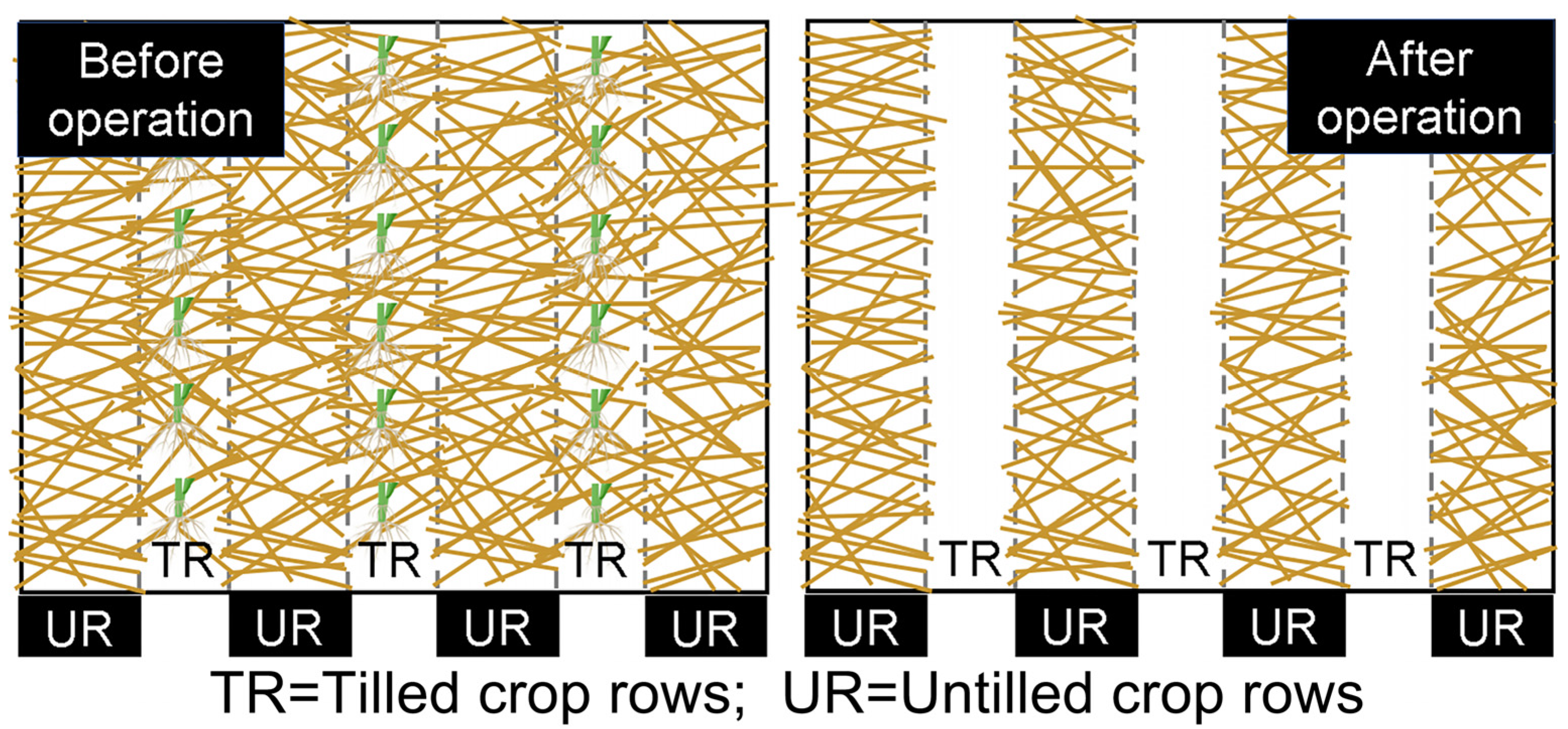
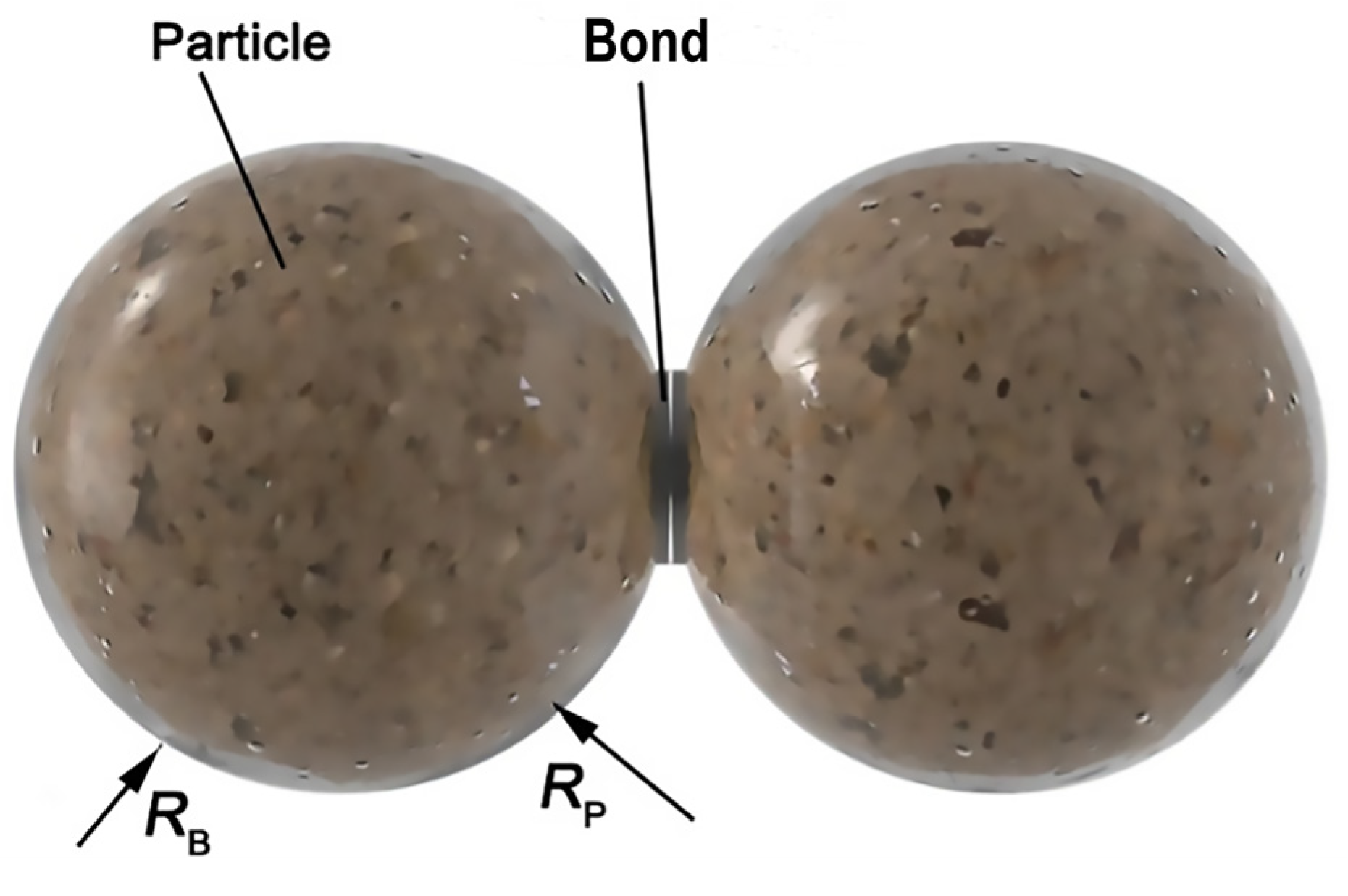
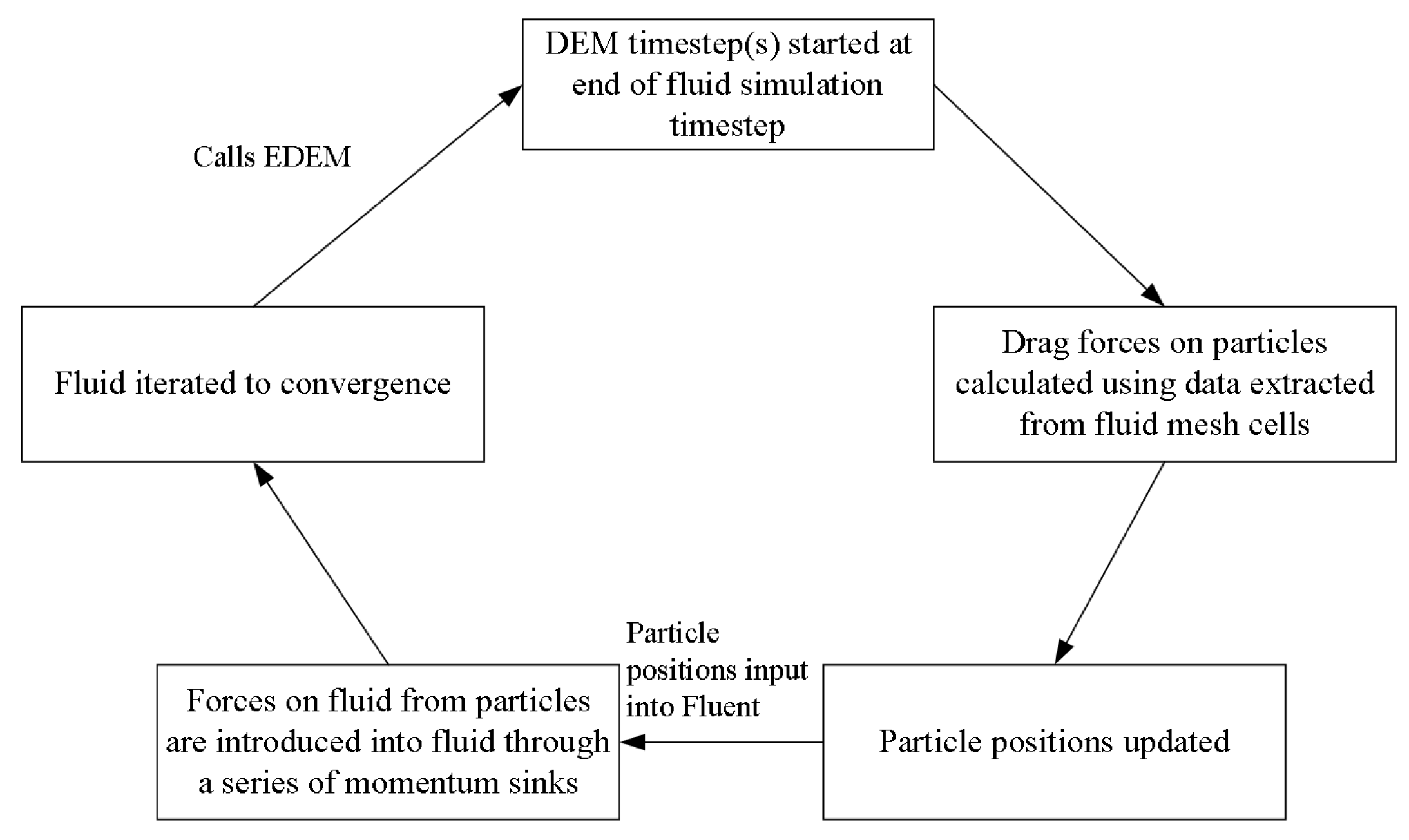

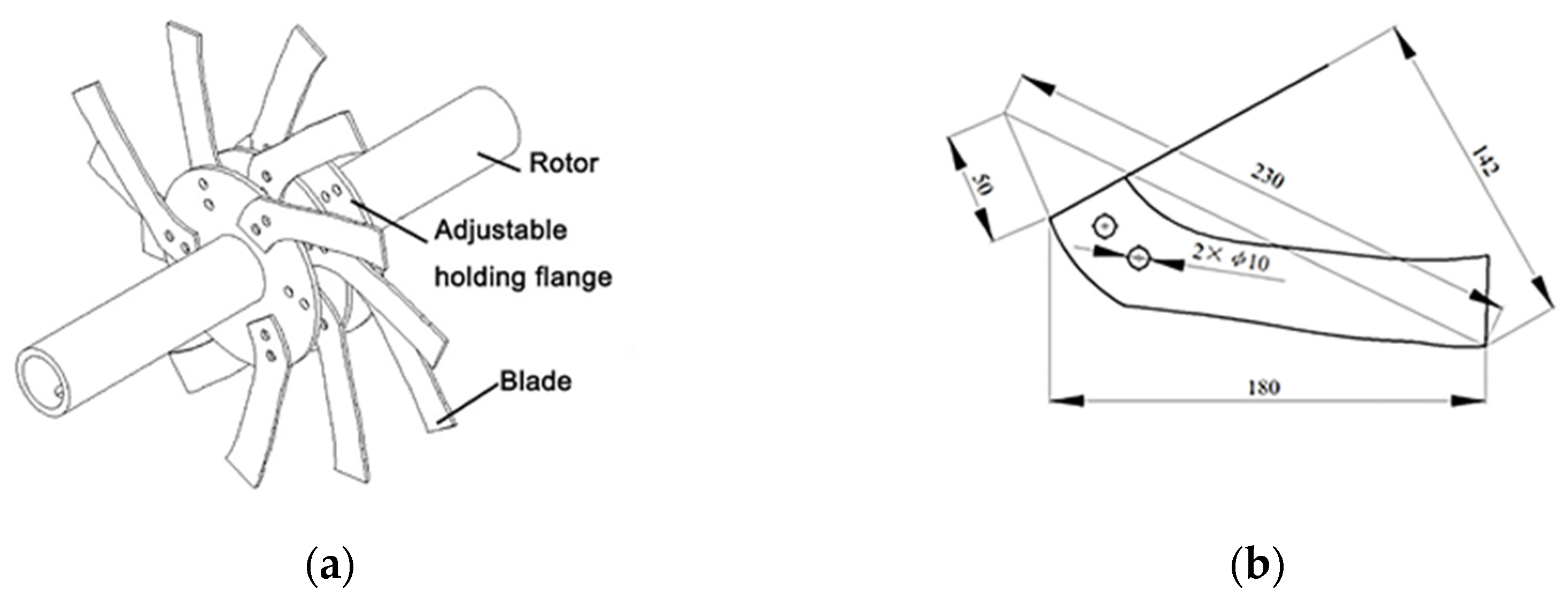


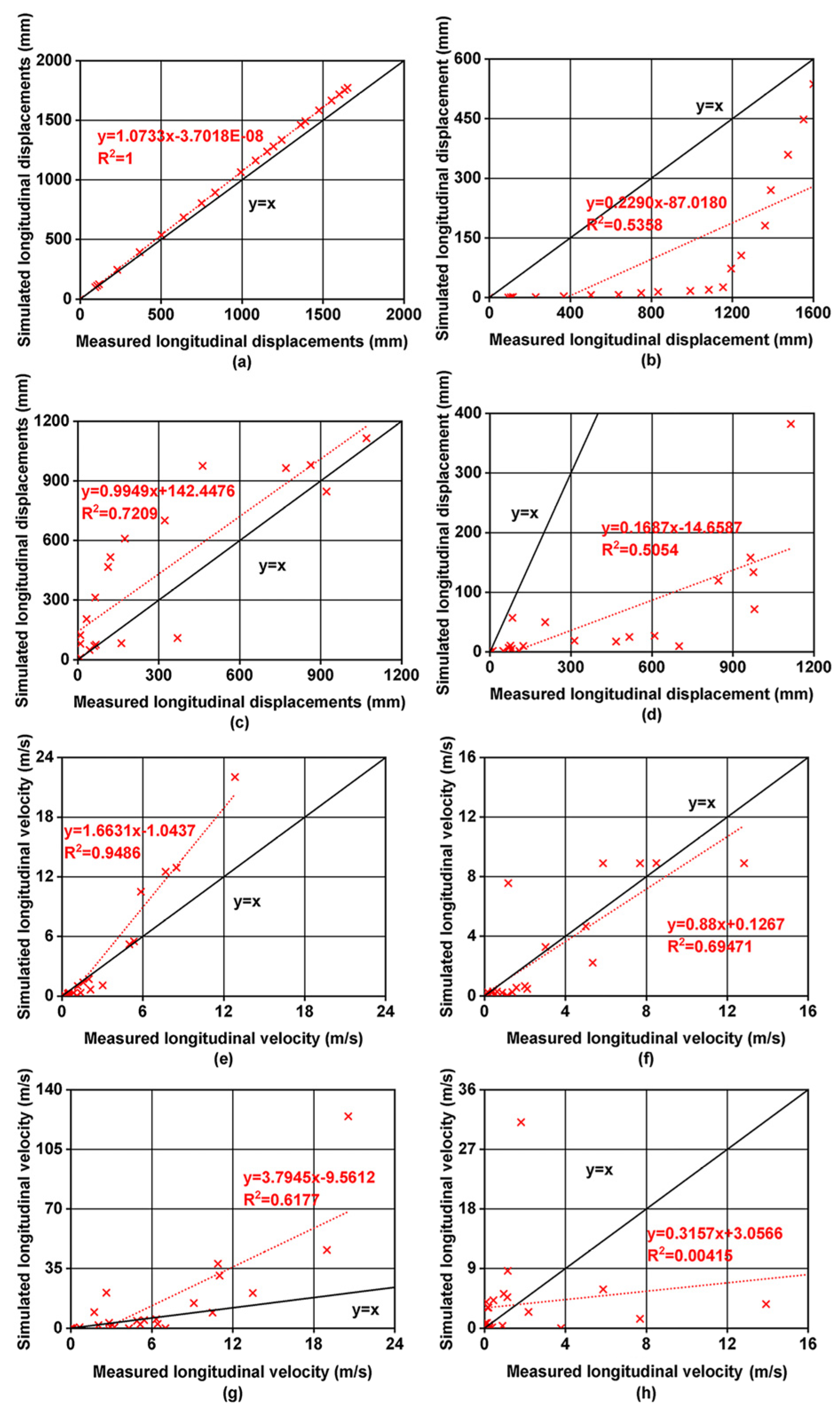
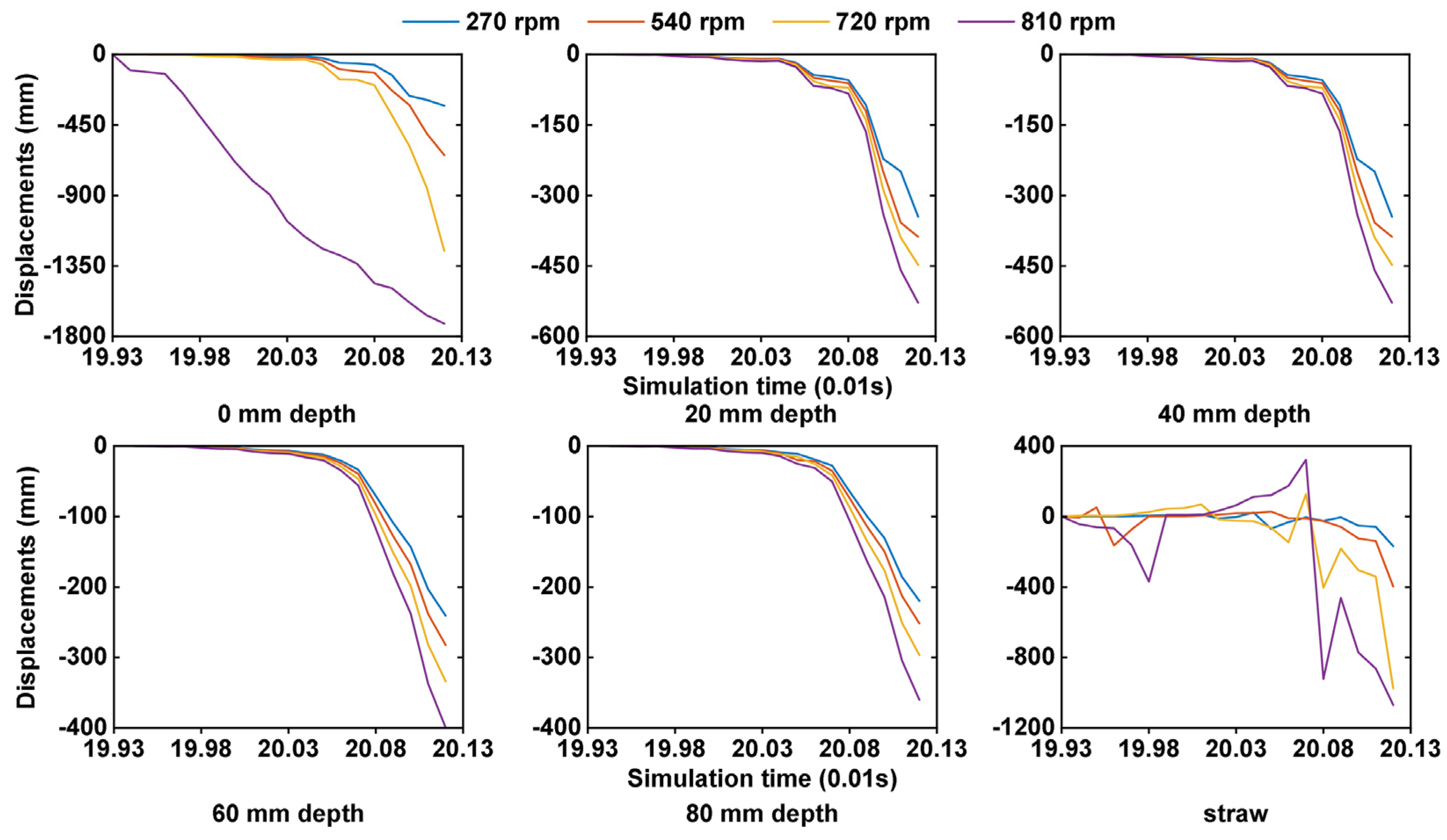

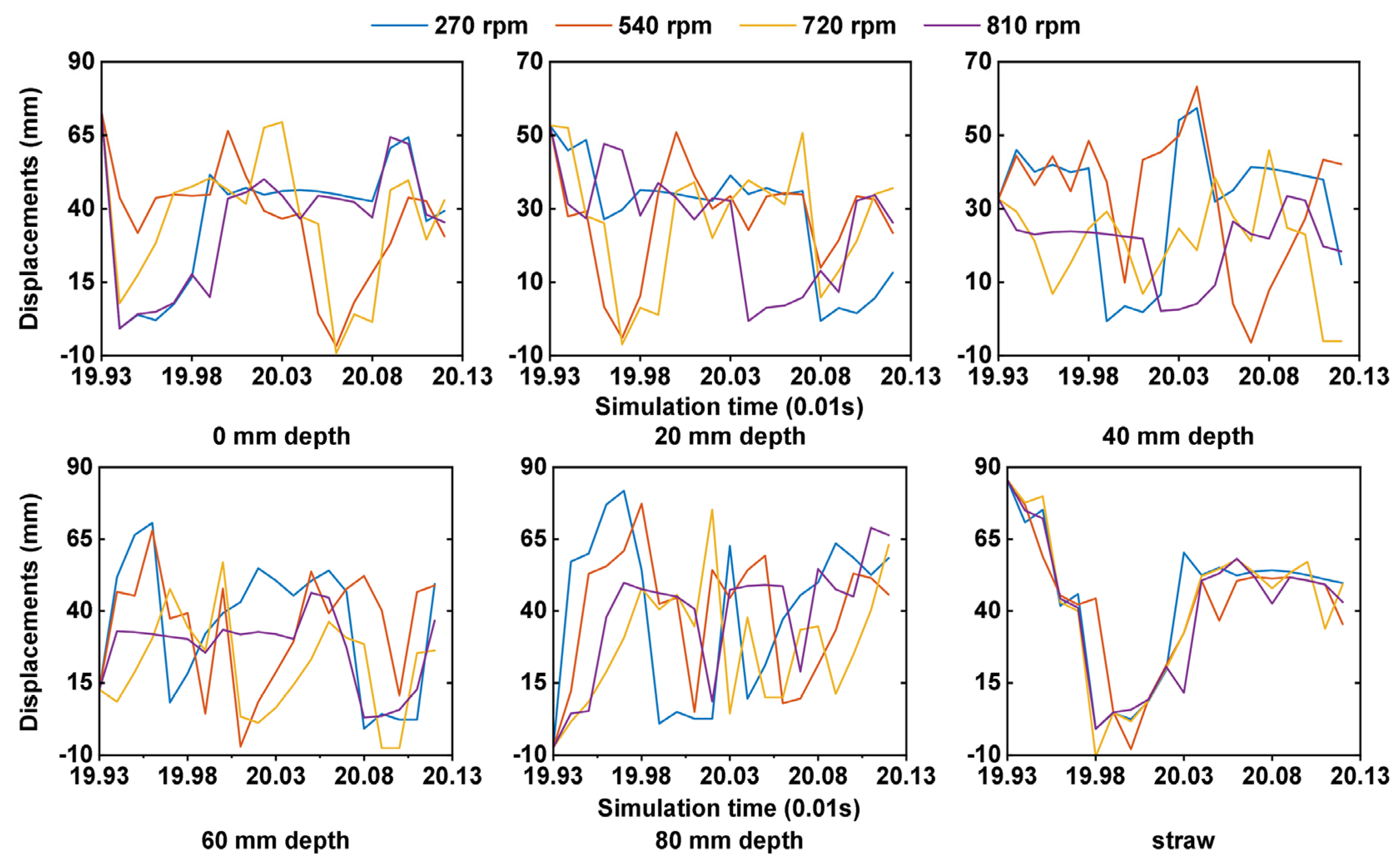

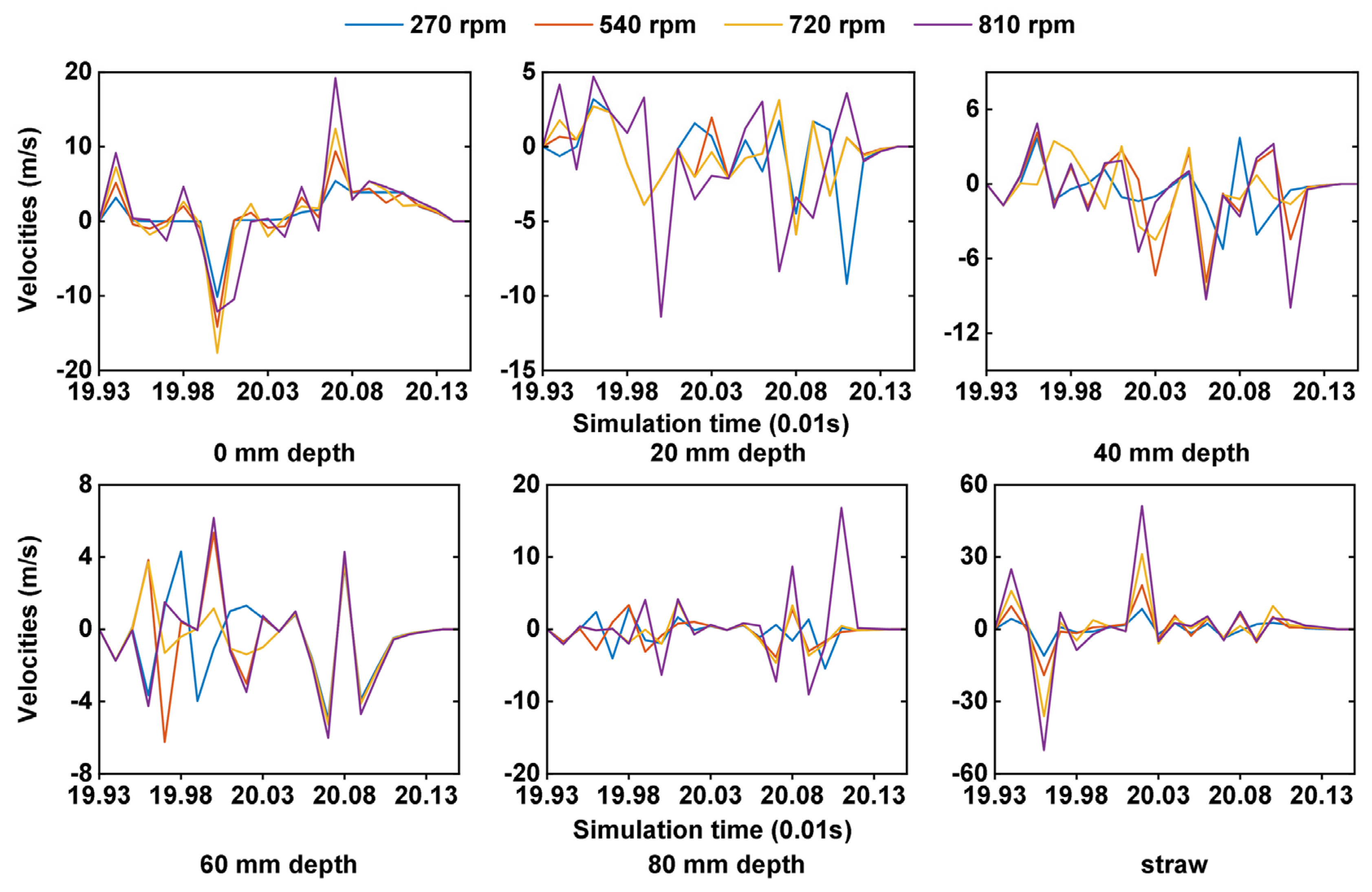

| Objects | Parameters and Units | Values |
|---|---|---|
| Soil | Poisson’s ratio | 0.41 |
| Shear modulus (MPa) | 1.24 × 106 | |
| Density (kg·m−3) | 2150 | |
| Coefficient of rolling friction | 0.2 | |
| Coefficient of static friction | 0.3 | |
| Coefficient of restitution | 0.6 | |
| Critical normal stress (kPa) | 200 | |
| Critical shear stress (kPa) | 68 | |
| Normal contact bond stiffness (N·m−1) | 3.4 × 108 | |
| Shear contact bond stiffness (N·m−1) | 1.5 × 108 | |
| Moisture | 20 ± 1% | |
| Straw | Poisson’s ratio | 0.4 |
| Density (kg·m−3) | 241 | |
| Shear modulus (MPa) | 1 | |
| Shear modulus (MPa) | 0.6 | |
| Coefficient of static friction | 0.01 | |
| Coefficient of static friction | 0.3 | |
| Critical normal stress (kPa) | 8.72 × 103 | |
| Critical shear stress (kPa) | 7.5 × 103 | |
| Normal contact bond stiffness (N·m−1) | 9.6 × 106 | |
| Shear contact bond stiffness (N·m−1) | 6.8 × 106 | |
| Stubble | Bonded radius (mm) | 1.79 |
| Poisson’s ratio | 0.33 | |
| Density (kg·m−3) | 107.64 | |
| Shear modulus (MPa) | 6.293 | |
| Coefficient of restitution | 0.6 | |
| Coefficient of rolling friction | 0.21 | |
| Coefficient of static friction | 0.573 | |
| Bond radius (mm) | 1.7 | |
| Critical normal stress (kPa) | 500 | |
| Critical shear stress (kPa) | 500 | |
| Normal contact bond stiffness (N·m−1) | 1.034 × 106 | |
| Shear contact bond stiffness (N·m−1) | 1.034 × 106 | |
| Blade | Shear modulus (MPa) | 7.9 × 104 |
| Poisson’s ratio | 0.3 | |
| Soil-stubble | Coefficient of restitution | 0.60 |
| Coefficient of static friction | 0.60 | |
| Coefficient of rolling friction | 0.02 | |
| Surface energy (J·m−2) | 10 | |
| Soil-blade | Coefficient of restitution | 0.6 |
| Coefficient of static friction | 0.313 | |
| Coefficient of rolling friction | 0.107 | |
| Straw-blade | Coefficient of static friction | 0.3 |
| Coefficient of rolling friction | 0.01 | |
| Stubble-blade | Coefficient of static friction | 0.6 |
| Coefficient of rolling friction | 0.02 |
| Source of Variation | Degree of Freedom | Soil F-Value | |||||
| X-Displacement | Y-Displacement | Z-Displacement | X-Velocity | Y-Velocity | Z-Velocity | ||
| Rotary speed, A | 3 | 1.434 ns | 0.153 ns | 5.449 ** | 3.696 ** | 0.041 ns | 0.126 ns |
| Airflow, B | 1 | 1.818 ns | 1.112 ns | 0.337 ns | 2.496 ns | 0.177 ns | 0.074 ns |
| AB | 3 | 0.823 ns | 0.096 ns | 0.322 ns | 0.078 ns | 0.027 ns | 0.101 ns |
| Error | 32 | ||||||
| Source of Variation | Degree of Freedom | Straw F-Value | |||||
| X-Displacement | Y-Displacement | Z-Displacement | X-Velocity | Y-Velocity | Z-Velocity | ||
| Rotary speed, A | 3 | 1.811 ns | 1.102 ns | 0.028 ns | 0.232 ns | 0.042 ns | 0.011 ns |
| Airflow, B | 2 | 3.830 * | 1.379 ns | 0.113 ns | 0.653 ns | 0.228 ns | 0.001 ns |
| AB | 2 | 0.247 ns | 0.003 ns | 0.074 ns | 0.088 ns | 0.009 ns | 0.027 ns |
| Error | 152 |
Disclaimer/Publisher’s Note: The statements, opinions and data contained in all publications are solely those of the individual author(s) and contributor(s) and not of MDPI and/or the editor(s). MDPI and/or the editor(s) disclaim responsibility for any injury to people or property resulting from any ideas, methods, instructions or products referred to in the content. |
© 2023 by the authors. Licensee MDPI, Basel, Switzerland. This article is an open access article distributed under the terms and conditions of the Creative Commons Attribution (CC BY) license (https://creativecommons.org/licenses/by/4.0/).
Share and Cite
Yuan, Y.; Wang, J.; Zhang, X.; Zhao, S. Effect of Rotary Speed on Soil and Straw Throwing Process by Stubble-Crushing Blade for Strip Tillage Using DEM-CFD. Agriculture 2023, 13, 877. https://doi.org/10.3390/agriculture13040877
Yuan Y, Wang J, Zhang X, Zhao S. Effect of Rotary Speed on Soil and Straw Throwing Process by Stubble-Crushing Blade for Strip Tillage Using DEM-CFD. Agriculture. 2023; 13(4):877. https://doi.org/10.3390/agriculture13040877
Chicago/Turabian StyleYuan, Yiwen, Jiayi Wang, Xin Zhang, and Shuhong Zhao. 2023. "Effect of Rotary Speed on Soil and Straw Throwing Process by Stubble-Crushing Blade for Strip Tillage Using DEM-CFD" Agriculture 13, no. 4: 877. https://doi.org/10.3390/agriculture13040877
APA StyleYuan, Y., Wang, J., Zhang, X., & Zhao, S. (2023). Effect of Rotary Speed on Soil and Straw Throwing Process by Stubble-Crushing Blade for Strip Tillage Using DEM-CFD. Agriculture, 13(4), 877. https://doi.org/10.3390/agriculture13040877









